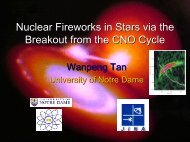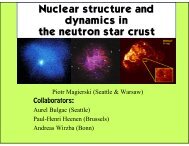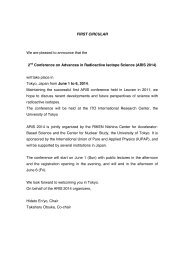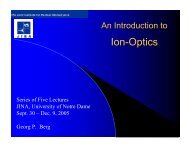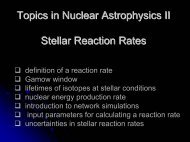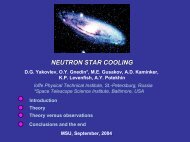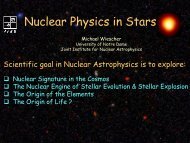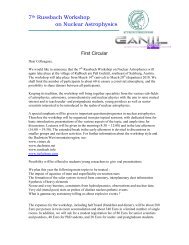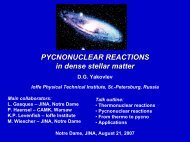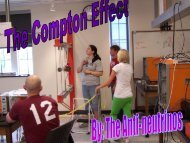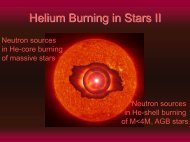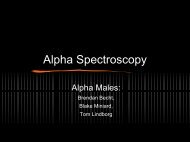Description of the proposed Facility for Rare-Isotope Beams (FRIB)
Description of the proposed Facility for Rare-Isotope Beams (FRIB)
Description of the proposed Facility for Rare-Isotope Beams (FRIB)
Create successful ePaper yourself
Turn your PDF publications into a flip-book with our unique Google optimized e-Paper software.
On Dec. 11, 2008, <strong>the</strong> U.S. Department <strong>of</strong> Energy (DOE) announced that Michigan State<br />
University (MSU) in East Lansing, MI has been selected to design and establish <strong>the</strong> <strong>Facility</strong> <strong>for</strong><br />
<strong>Rare</strong> <strong>Isotope</strong> <strong>Beams</strong> (<strong>FRIB</strong>), a cutting-edge research facility to advance understanding <strong>of</strong> rare<br />
nuclear isotopes and <strong>the</strong> evolution <strong>of</strong> <strong>the</strong> cosmos. The new facility—expected to take about a<br />
decade to design and build and to cost an estimated $550 million—will provide research<br />
opportunities <strong>for</strong> an international community <strong>of</strong> approximately 1000 university and laboratory<br />
scientists, postdoctoral associates, and graduate students.<br />
MSU has <strong>proposed</strong> an <strong>FRIB</strong> that af<strong>for</strong>ds users opportunities with fast, stopped, and reaccelerated<br />
beams <strong>of</strong> rare isotopes and is <strong>proposed</strong> to adjoin <strong>the</strong> current NSCL facility as shown in Figure 1.<br />
Figure 1: Proposed configuration <strong>of</strong> <strong>FRIB</strong> at MSU.<br />
In preparing its application MSU made many choices but <strong>the</strong>se choices are not final. After a<br />
Cooperative Agreement between DOE and MSU has been established, <strong>the</strong>se choices will be<br />
reexamined in an alternatives analysis with opportunity <strong>for</strong> community input. The resulting<br />
Conceptual Design Report is subject to approval by DOE. Subsequently a base-lined design will<br />
be developed which is also subject to DOE approval.<br />
1
The MSU application proposes<br />
• Superconducting-RF driver linear accelerator that provides 400 kW <strong>for</strong> all beams with<br />
uranium accelerated to 200 MeV/nucleon and lighter ions with increasing energy<br />
(protons at 600 MeV/nucleon)<br />
• Two ECR ion sources <strong>for</strong> redundancy with space to add a third ECR ion source<br />
• Space in <strong>the</strong> linac tunnel and shielding in <strong>the</strong> production area to upgrade <strong>the</strong> driver linac<br />
energy to 400 MeV/u <strong>for</strong> uranium and 1 GeV <strong>for</strong> protons without significant interruption<br />
<strong>of</strong> <strong>the</strong> future science program<br />
• Space to add multi-user capability<br />
• One in-flight production target<br />
• Space and infrastructure to add up to two ISOL targets or one additional in-flight<br />
production target with shielding to accommodate 1 GeV proton beams at 400 kW<br />
• Three stopping stations (two gas stopping stations and one solid stopper)<br />
• A superconducting-RF reaccelerator <strong>for</strong> reaccelerated beams up to 12 MeV/nucleon<br />
(uranium) and higher energies <strong>for</strong> lighter beams (e.g. 21 MeV/nucleon <strong>for</strong> 48 Cr)<br />
• Experimental areas (47,000 sq ft) <strong>for</strong> stopped beams, reaccelerated beams, and fast beams<br />
(Figure 2)<br />
• Upgrade options include doubling <strong>the</strong> size <strong>of</strong> <strong>the</strong> experimental area or adding a neutron<br />
scattering facility<br />
• Allowance <strong>for</strong> experimental equipment<br />
• Opportunity <strong>for</strong> a pre-<strong>FRIB</strong> science program using <strong>the</strong> existing in-flight separated beams<br />
from <strong>the</strong> Coupled Cyclotron <strong>Facility</strong> and <strong>the</strong> ReA3 reaccelerator. Users will be able to<br />
mount and test equipment and techniques with beams at all energies in-situ so that <strong>the</strong>y<br />
are immediately ready <strong>for</strong> experiments when <strong>FRIB</strong> is complete. This will allow <strong>for</strong> a<br />
seamless science program during <strong>the</strong> time <strong>FRIB</strong> is under construction.<br />
• User Relations Office during establishment <strong>of</strong> <strong>FRIB</strong> facility to support development <strong>of</strong><br />
user programs and experimental equipment<br />
• Venues <strong>for</strong> community input through an <strong>FRIB</strong> Users Organization (<strong>for</strong> individual users)<br />
and <strong>the</strong> <strong>Rare</strong> <strong>Isotope</strong> Research and Education Board (<strong>for</strong> institutions)<br />
• Strong Governance through President’s Project Advisory Committee (chaired by Ernie<br />
Moniz), Science Advisory Committee (chaired by Rick Casten), Project Management<br />
Oversight Group (chaired by Jim Yeck), Accelerator Systems Advisory Committee<br />
(chaired by Satoshi Ozaki) and Experimental Systems Advisory Committee (chaired by<br />
Jay Marx)<br />
2
Figure 2: Proposed experimental area configuration <strong>of</strong> <strong>FRIB</strong> at MSU. F, S, R refer to Fast,<br />
Stopped, and Reaccelerated beam areas. The color code indicates <strong>the</strong> <strong>proposed</strong> completion time.<br />
Links:<br />
DOE announcement < http://www.sc.doe.gov/np/program/<strong>FRIB</strong>.html><br />
DOE Fact Sheet: <strong>Facility</strong> <strong>for</strong> <strong>Rare</strong> <strong>Isotope</strong> <strong>Beams</strong> Applicant Selection<br />
< http://www.energy.gov/6795.htm><br />
3



